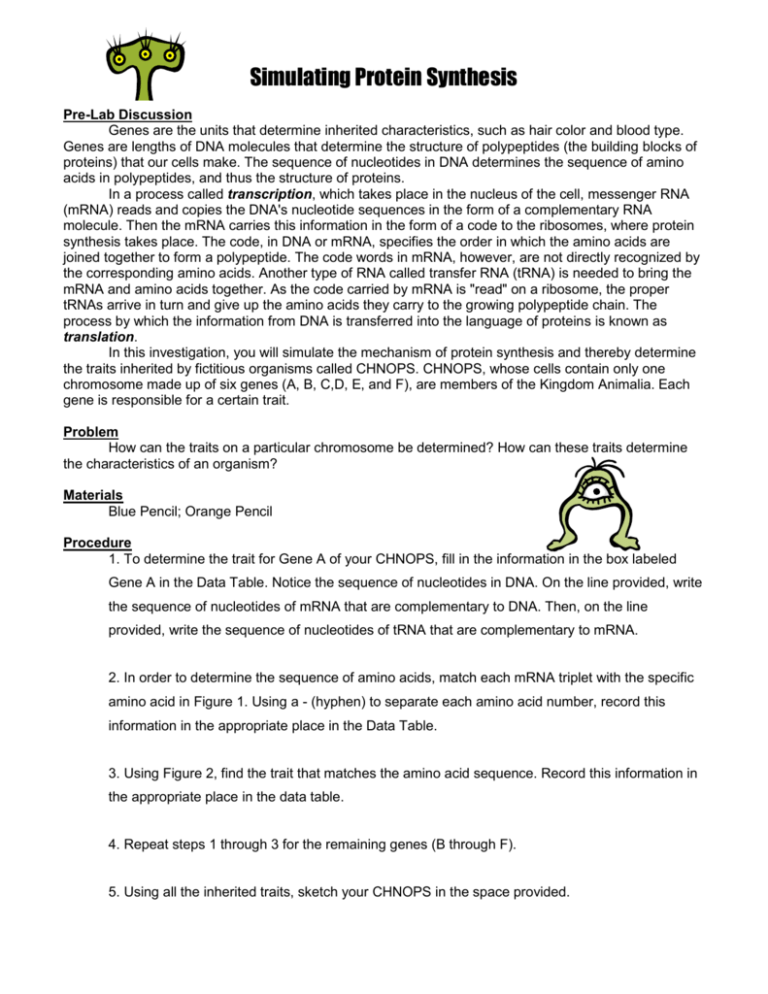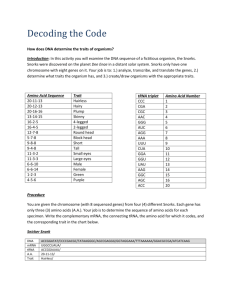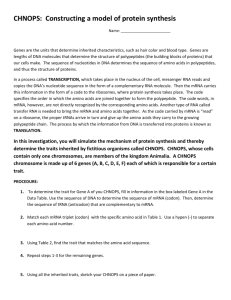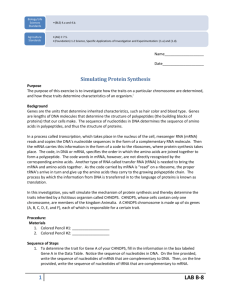CHNOPS Simulating Protein Synthesis
advertisement

Simulating Protein Synthesis Pre-Lab Discussion Genes are the units that determine inherited characteristics, such as hair color and blood type. Genes are lengths of DNA molecules that determine the structure of polypeptides (the building blocks of proteins) that our cells make. The sequence of nucleotides in DNA determines the sequence of amino acids in polypeptides, and thus the structure of proteins. In a process called transcription, which takes place in the nucleus of the cell, messenger RNA (mRNA) reads and copies the DNA's nucleotide sequences in the form of a complementary RNA molecule. Then the mRNA carries this information in the form of a code to the ribosomes, where protein synthesis takes place. The code, in DNA or mRNA, specifies the order in which the amino acids are joined together to form a polypeptide. The code words in mRNA, however, are not directly recognized by the corresponding amino acids. Another type of RNA called transfer RNA (tRNA) is needed to bring the mRNA and amino acids together. As the code carried by mRNA is "read" on a ribosome, the proper tRNAs arrive in turn and give up the amino acids they carry to the growing polypeptide chain. The process by which the information from DNA is transferred into the language of proteins is known as translation. In this investigation, you will simulate the mechanism of protein synthesis and thereby determine the traits inherited by fictitious organisms called CHNOPS. CHNOPS, whose cells contain only one chromosome made up of six genes (A, B, C,D, E, and F), are members of the Kingdom Animalia. Each gene is responsible for a certain trait. Problem How can the traits on a particular chromosome be determined? How can these traits determine the characteristics of an organism? Materials Blue Pencil; Orange Pencil Procedure 1. To determine the trait for Gene A of your CHNOPS, fill in the information in the box labeled Gene A in the Data Table. Notice the sequence of nucleotides in DNA. On the line provided, write the sequence of nucleotides of mRNA that are complementary to DNA. Then, on the line provided, write the sequence of nucleotides of tRNA that are complementary to mRNA. 2. In order to determine the sequence of amino acids, match each mRNA triplet with the specific amino acid in Figure 1. Using a - (hyphen) to separate each amino acid number, record this information in the appropriate place in the Data Table. 3. Using Figure 2, find the trait that matches the amino acid sequence. Record this information in the appropriate place in the data table. 4. Repeat steps 1 through 3 for the remaining genes (B through F). 5. Using all the inherited traits, sketch your CHNOPS in the space provided. Figure 1 mRNA Triplet UGG UCG GCU UUG GCG CCC UCC UUU AAA CCA AUA GGG UAG GAU CCU CGG GUC GUU UGC CGA Amino Acid Number 20 16 2 4 3 5 7 8 9 12 13 1 6 10 11 21 15 19 17 18 Figure 2 Amino Acid Sequence 20-11-13 20-12-13 20-21-21 13-14-15 16-2 12-7-8-1 5-7-8-1 9-8 9-4 11-3-2 11-3-3 6-6-10 6-6-14 Trait hairless hairy plump skinny four-legged long nose short nose no freckles freckles blue skin orange skin male female Name __________________________________________ CHNOPS WORKSHEETObservations Data Table Gene A Gene B DNA: DNA: ACC GGT TAT Period _______Date _________ Simulating Protein Synthesis Gene C AGC CGA DNA: TTT AAC mRNA: __________________ mRNA: __________________ mRNA: __________________ tRNA: __________________ tRNA: __________________ tRNA: __________________ Amino Acid Sequence: Amino Acid Sequence: Amino Acid Sequence: _______________________ _______________________ _______________________ Trait (phenotype): __________________ Trait (phenotype): __________________ Trait (phenotype): __________________ Gene D Gene E Gene F DNA: GGA CGC CGC DNA: GGG AGG AAA CCC DNA: ATC ATC GCC mRNA: __________________ mRNA: __________________ mRNA: __________________ tRNA: __________________ tRNA: __________________ tRNA: __________________ Amino Acid Sequence: Amino Acid Sequence: Amino Acid Sequence: _______________________ _______________________ _______________________ Trait (phenotype): __________________ Trait (phenotype): __________________ Trait (phenotype): __________________ mRNA Triplet UGG UCG GCU UUG GCG CCC UCC UUU AAA CCA AUA GGG UAG GAU CCU CGG GUC GUU UGC CGA Amino Acid Number 20 16 2 4 3 5 7 8 9 12 13 1 6 10 11 14 15 19 17 18 Amino Acid Sequence 20-11-13 20-12-13 20-14-9 13-14-15 16-2 12-7-8-1 5-7-8-1 9-8 9-4 11-3-2 11-3-3 6-6-10 6-6-14 Trait hairless hairy plump skinny four-legged long nose short nose no freckles freckles blue skin orange skin male female Analysis & Conclusions 1. Distinguish between transcription & translation. ____________________________________________________________________________________ ____________________________________________________________________________________ ____________________________________________________________________________________ ____________________________________________________________________________________ 2. What is the specific site for transcription & translation in the cell? ____________________________________________________________________________________ ____________________________________________________________________________________ 3. How many tRNA nucleotides form an anticodon that will attach to the mRNA codon? ________________ 4. What is the difference between a codon and an anti-codon? ____________________________________________________________________________________ ____________________________________________________________________________________ Procedure 1. To determine the trait for Gene A of your CHNOPS, fill in the information in the box labeled Gene A in the Data Table. Notice the sequence of nucleotides in DNA. On the line provided, write the sequence of nucleotides of mRNA that are complementary to DNA. Then, on the line provided, write the sequence of nucleotides of tRNA that are complementary to mRNA. 2. In order to determine the sequence of amino acids, match each mRNA triplet with the specific amino acid in Figure 1. Using a - (hyphen) to separate each amino acid number, record this information in the appropriate place in the Data Table. 3. Using Figure 2, find the trait that matches the amino acid sequence. Record this information in the appropriate place in the data table. 4. Repeat steps 1 through 3 for the remaining genes (B through F). 5. Using all the inherited traits, sketch your CHNOPS in the space provided.








